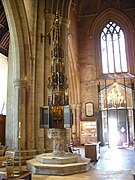
Lincoln Cathedral, also called Lincoln Minster and formally the Cathedral Church of the Blessed Virgin Mary of Lincoln, is a Church of England cathedral in Lincoln, England. It is the seat of the bishop of Lincoln and is the mother church of the diocese of Lincoln. The cathedral is governed by its dean and chapter, and is a grade I listed building.

St Botolph's Church is the Anglican parish church of Boston, Lincolnshire, England. It has been referred to as "Boston Stump" since it was constructed. Its tower is 266 feet 9 inches (81.31 m) tall, and was long used as a landmark for the Boston fishermen; on a clear day it can be seen from Norfolk. The church is a Grade I listed building.

The Cathedral of the Blessed Virgin Mary is a Church of England cathedral in the city of Truro, Cornwall. It was built between 1880 and 1910 to a Gothic Revival design by John Loughborough Pearson on the site of the parish church of St Mary. It is one of only three cathedrals in the United Kingdom featuring three spires.

The Cathedral Church of St. James is an Anglican cathedral in Downtown Toronto, Ontario, Canada. It is the location of the oldest congregation in the city, with the parish being established in 1797. The church, with construction beginning in 1850 and opening for services on June 19, 1853, was one of the largest buildings in the city at that time. It was designed by Frederick William Cumberland and is a prime example of Gothic Revival architecture.

St Peter Mancroft is a parish church in the Church of England in the centre of Norwich, Norfolk. After the two cathedrals, it is the largest church in Norwich. It was originally established by Ralph de Gael, Earl of East Anglia, between 1066 and 1075. It was later rebuilt, between 1430 and 1455. It stands on a slightly elevated position, next to the market place.
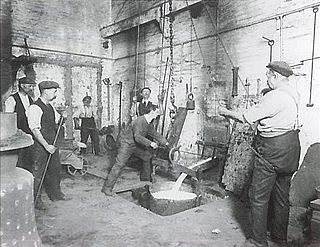
Gillett & Johnston was a clockmaker and bell foundry based in Croydon, England from 1844 until 1957. Between 1844 and 1950, over 14,000 tower clocks were made at the works. The company's most successful and prominent period of activity as a bellfounder was in the 1920s and 1930s, when it was responsible for supplying many important bells and carillons for sites across Britain and around the world.

St Martin in the Bull Ring is a Church of England parish church in the city of Birmingham, West Midlands, England. It is the original parish church of Birmingham and stands between the Bull Ring Shopping Centre and the markets.
Field Flowers Goe was an Anglican Bishop of Melbourne.

Hull Minster is the Anglican minster and the parish church of Kingston upon Hull in the East Riding of Yorkshire, England. The church was called Holy Trinity Church until 13 May 2017 when it became Hull Minster.
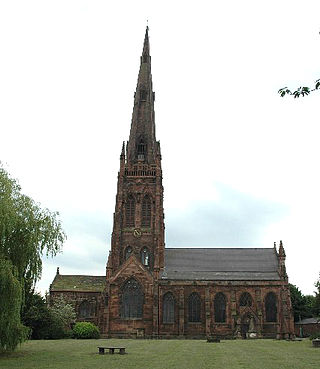
St Elphin's Church is the parish church of the town of Warrington, Cheshire, England. The church is recorded in the National Heritage List for England as a designated Grade II* listed building. It is an active Anglican parish church in the diocese of Liverpool, the archdeaconry of Warrington and the deanery of Warrington.
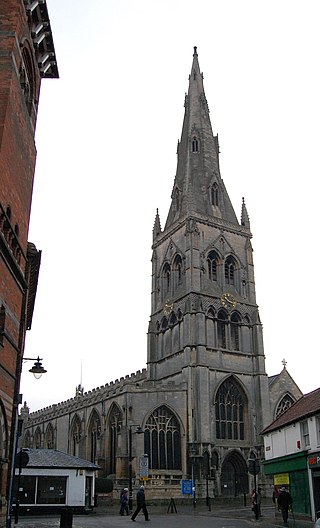
St Mary Magdalene Church, Newark-on-Trent is the parish church of Newark-on-Trent in Nottinghamshire, England. It is dedicated to Mary Magdalene and is the tallest structure in the town.
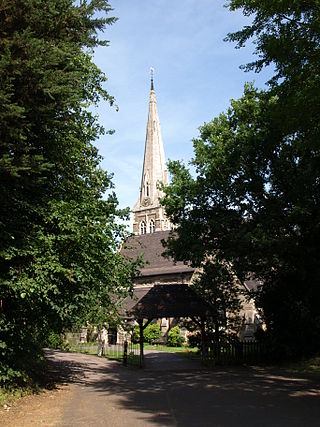
St. Mary's Church, Selly Oak is a Church of England parish church in Selly Oak, Birmingham, England.

St James' Church, Louth, is the Anglican parish church of Louth in Lincolnshire, England. It is notable for having the third tallest spire in the whole of the United Kingdom. The church was the site of the Lincolnshire Rising, starting in October 1536 and led by the vicar, who was drawn and quartered for his actions.

St Mary's Church, Stamford is a parish church of the Church of England, located in Stamford, Lincolnshire, lending its name to St Mary's Hill on which it stands, and which runs down to the river crossing opposite The George Hotel.

St Mary is the parish church of Melton Mowbray, Leicestershire. The large medieval church, described as "one of the finest parish churches in Leicestershire", suffered from a poor Victorian restoration, and was left in a poor state of repair and deemed "unfit for purpose". By late 2017, work was completed to make the church more accessible and safe, which included a new floor and underfloor heating, a lighting and sound system and a rebuild of the historic organ; the reordering cost an approximate £2 million.

St Paul's is a Church of England church in the Georgian St Pauls Square in the Jewellery Quarter, Birmingham, England.

All Saints' Church, Oakham is a parish church in the Church of England in Oakham, Rutland. It is Grade I listed.
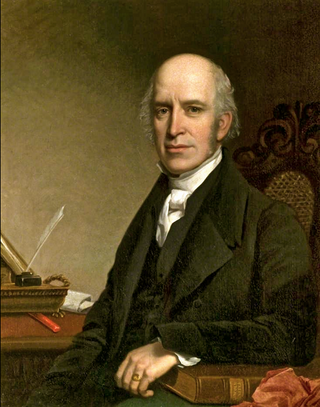
Edward James Willson was an English architect, antiquary, architectural writer, and mayor of Lincoln in 1851–2.
Henry Oswald Hodgson FRCO was an organist and composer based in England.




